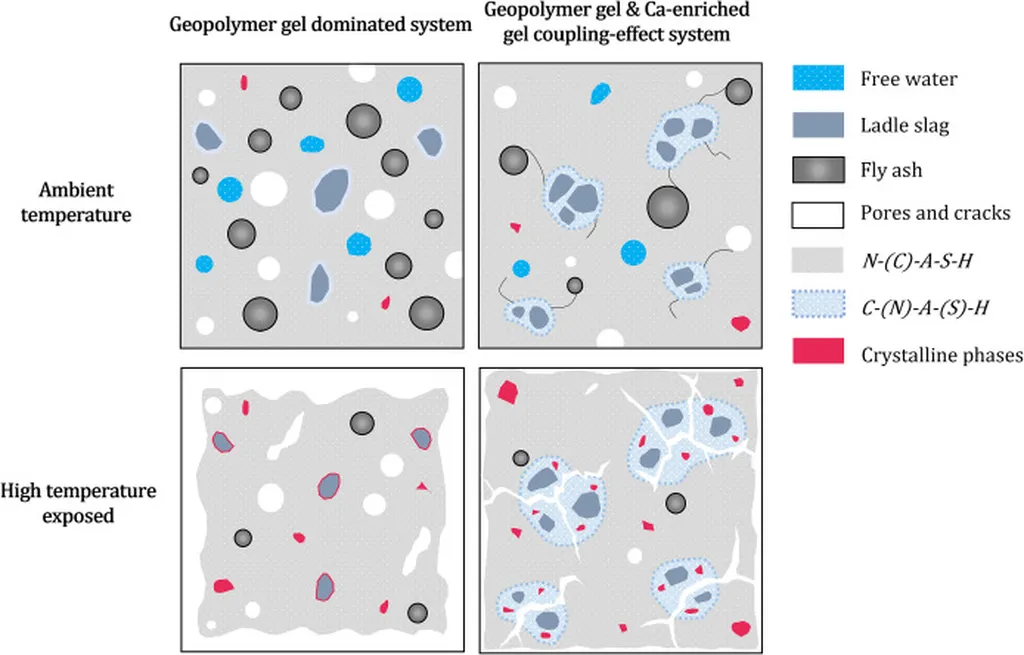In the quest for sustainable construction materials, geopolymers have emerged as a promising alternative to traditional Portland cement, offering a more eco-friendly solution for concrete production. A recent study published in the journal *AIMS Materials Science* (translated from Chinese as “Materials Science”) sheds new light on the thermal properties of sodium aluminosilicate hydrate (N-A-S-H) gel, a key component in geopolymer concrete. The research, led by Yun-Lin Liu from the College of Civil Engineering at Anhui Jianzhu University in China, explores how variations in molecular structure and temperature affect the thermal conductivity of N-A-S-H gel, with significant implications for the energy sector.
Geopolymer materials have gained traction for their lower carbon footprint compared to conventional cement. However, their performance at elevated temperatures has not been thoroughly understood. Liu’s study aims to fill this gap by investigating the molecular dynamics of N-A-S-H gel under different conditions. “Understanding the thermal behavior of N-A-S-H is crucial for its application in high-temperature environments,” Liu explains. “This knowledge can help optimize the design of geopolymer materials for various industrial and energy-related applications.”
The research team employed molecular dynamics (MD) modeling to analyze the structural variations of N-A-S-H gel within a temperature range of 300–900 Kelvin (approximately 27 to 627 degrees Celsius). They focused on the influence of different silicon-to-aluminum (Si/Al) ratios and temperature levels on molecular characteristics and atomic mobility. Using the radial distribution function (RDF) and mean square displacement (MSD), they observed that as temperature increases, the mobility of silicon (Si) and aluminum (Al) atoms is enhanced.
One of the key findings of the study is the determination of the thermal conductivity of N-A-S-H gel, which ranges from 1.431 to 1.857 watts per meter per Kelvin (W/m/K). Notably, the thermal conductivity increases with higher Si/Al ratios and elevated temperatures. “This suggests that the thermal insulation performance of N-A-S-H gel decreases at higher Si/Al ratios and temperatures,” Liu notes. “This insight is valuable for tailoring geopolymer materials to specific thermal requirements in construction and energy applications.”
The implications of this research are far-reaching for the energy sector. As the demand for sustainable and energy-efficient building materials grows, understanding the thermal properties of geopolymers becomes increasingly important. The findings can guide the development of geopolymer concretes that are better suited for high-temperature environments, such as industrial facilities, energy storage systems, and fire-resistant structures.
Moreover, the study highlights the potential for optimizing the Si/Al ratio in geopolymer formulations to achieve desired thermal properties. This could lead to the creation of advanced materials that offer improved thermal management and energy efficiency in various applications.
As the construction industry continues to seek innovative solutions for sustainable development, the insights provided by Liu’s research offer a promising path forward. By leveraging molecular dynamics modeling and advanced analytical techniques, scientists can unlock the full potential of geopolymer materials, paving the way for a more sustainable and energy-efficient future.
In the words of Yun-Lin Liu, “This research not only advances our understanding of N-A-S-H gel but also opens new avenues for the application of geopolymers in the energy sector. It is an exciting time for materials science and engineering, and we are eager to see how these findings will shape the future of sustainable construction.”

